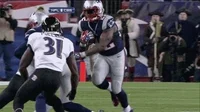How
many hits to the head is too much?
Heidelberg
 Whether
some American football players suffer from concussion after a hit on the head
may depend on the number and severity of head impacts that they sustain in the
days, weeks, and months leading up to the concussion, rather than a single
large head impact.
Whether
some American football players suffer from concussion after a hit on the head
may depend on the number and severity of head impacts that they sustain in the
days, weeks, and months leading up to the concussion, rather than a single
large head impact. This is according to Brian Stemper of the Marquette University and Medical College of Wisconsin in the US. Stemper is lead author of a study on concussion in college football in the Springer-branded journal Annals of Biomedical Engineering.
The findings provide further support for policies that try to limit head impact exposure during football training and games.
Many
studies have already shown how the structure and function of American football
players brains change throughout the course of their careers. This happens with
or without them ever being diagnosed with concussion after head impacts.
The findings of these studies suggest that damage to the brain following successive head impacts reaches a certain tipping point, by which an athlete’s chances of suffering concussion increases.
The findings of these studies suggest that damage to the brain following successive head impacts reaches a certain tipping point, by which an athlete’s chances of suffering concussion increases.
 To
investigate whether repetitive head impacts play a role in the onset of
concussion in college football players, Stemper and his colleagues turned to
Division 1 of America’s National Collegiate Athletic Association (NCAA).
To
investigate whether repetitive head impacts play a role in the onset of
concussion in college football players, Stemper and his colleagues turned to
Division 1 of America’s National Collegiate Athletic Association (NCAA). The researchers matched 50 athletes suffering concussion with others who did not, but who played in the same position and were on the same team.
The
analysis shows that repetitive head impact exposure plays a role in the
occurrence of concussive injuries in some college football athletes.
Overall, compared to the players in the control group, 72 per cent of the concussed athletes in the study experienced more exposure to head impacts either on the day of suffering a concussion, or during the season leading up to the event.
The link between cumulative exposure to head impacts and a subsequent onset of concussion was more pronounced among athletes taking part in more contact activities.
For example, 82 per cent of athletes who participated in ten or more days of contact play had greater head impact exposure than their matched control group.
Overall, compared to the players in the control group, 72 per cent of the concussed athletes in the study experienced more exposure to head impacts either on the day of suffering a concussion, or during the season leading up to the event.
The link between cumulative exposure to head impacts and a subsequent onset of concussion was more pronounced among athletes taking part in more contact activities.
For example, 82 per cent of athletes who participated in ten or more days of contact play had greater head impact exposure than their matched control group.
“This
unique analysis provides further evidence for the role of repetitive head
impact exposure as a predisposing factor for the onset of concussion among
Division 1 college football athletes,” says Stemper.
“While these trends require further validation, the clinical implication of these findings supports the contemporary trend of limiting head impact exposure for college football athletes during practice sessions.”
“While these trends require further validation, the clinical implication of these findings supports the contemporary trend of limiting head impact exposure for college football athletes during practice sessions.”
Reference: Stemper,
B.D. et al (2018). Comparison of Head Impact Exposure Between
Concussed Football Athletes and Matched Controls: Evidence for a Possible
Second Mechanism of Sport-Related Concussion, Annals of Biomedical
Engineering DOI: 10.1007/s10439-018-02136-6